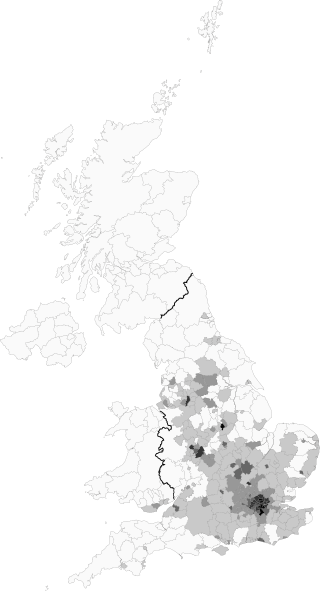Top Qs
Timeline
Chat
Perspective
Mixed (United Kingdom ethnicity category)
Ethnicity category From Wikipedia, the free encyclopedia
Remove ads
Mixed is an ethnic group category that was first introduced by the United Kingdom's Office for National Statistics for the 2001 Census. Colloquially, it refers to British citizens or residents whose parents are of two or more races or ethnic backgrounds. The Mixed or Multiple ethnic group numbered just under 1.8 million in the 2021 United Kingdom census or 2.7% of the total UK population.[6][2][3]
Remove ads
Remove ads
Statistics
Summarize
Perspective
A number of academics have pointed out that the ethnicity classification employed in the census and other official statistics in the UK since 1991 involve confusion between the concepts of ethnicity and race.[7][8] Aspinall notes that sustained academic attention has been focused on "how the censuses measure ethnicity, especially the use of dimensions that many claim have little to do with ethnicity, such as skin colour, race, and nationality".[9]
The year 2001 was the first census which asked about mixed race identity. In that census, 677,177 classified themselves as of mixed ethnicity, making up 1.2 percent of the country's population.[10] The 2011 Census gave the figure as 2.2% for England and Wales.[11]
Office for National Statistics estimates suggest that 956,700 mixed-ethnicity people were resident in England (as opposed to the whole of the country) as of mid-2009, compared to 654,000 at mid-2001.[12] As of May 2011, this figure surpassed 1 million.[13] It was estimated in 2007 that, by 2020, 1.24 million people in the UK would be of mixed race.[14] Research conducted by the BBC, however, suggests that the mixed race population could already be twice the official estimate figure - up to 2 million.[15] According to The Economist in October 2020, the 2011 census figure "is probably an undercount, since not all children of mixed marriages will have ticked one of the mixed categories, and the number is likely to have grown since the census".[16]
3.5 percent of all births in England and Wales in 2005 were mixed-ethnicity babies, with 0.9 percent being 'Mixed White and Black Caribbean', 0.5 percent 'Mixed White and Black African', 0.8 percent 'Mixed White and Asian', and 1.3 percent any other mixed background.[17]
Remove ads
Population
Summarize
Perspective



The 2021 United Kingdom census recorded a population of 1,793,257 or 2.7% of the population in the United Kingdom. When broken down by country, England recorded 1,669,378 (3.0%), Wales recorded 48,598 (1.6%)[1] and Northern Ireland recorded 14,382 (0.8%).[3] The equivalent census was recorded a year later in Scotland with a population of 60,899, or 1.1% of the population.[2] The ten local authorities with the largest proportion of those who identified as Mixed were all located in London: Lambeth (8.07%), Lewisham (8.07%), Croydon (7.61%), Islington (7.49%), Southwark (7.20%), Haringey (7.02%), Hackney (6.75%), Hammersmith and Fulham (6.73%), Kensington and Chelsea (6.64%) and Camden (6.63%). The three capitals of the other constituent countries of the United Kingdom held the highest proportion of the Mixed population in their respective countries with Cardiff at 4.00%, Edinburgh at 2.50%, and Belfast at 1.20%.[28]
Year of arrival (2021 census, England and Wales)[29]
- Born in the UK (81.8%)
- Before 1950 (0.1%)
- 1951 to 1960 (0.4%)
- 1961 to 1970 (0.8%)
- 1971 to 1980 (0.7%)
- 1981 to 1990 (0.9%)
- 1991 to 2000 (2%)
- 2001 to 2010 (4.2%)
- 2011 to 2021 (9.2%)
Remove ads
Subgroups
Summarize
Perspective
In England and Wales, the 2001 census included four sub-categories of mixed ethnic combinations: "Mixed White and Black Caribbean", "Mixed White and Black African", "Mixed White and Asian" and "Any other Mixed background", with the latter allowing people to write in their ethnicity. Analysis of census results shows that, in England and Wales only, 237,000 people stated their ethnicity as Mixed White and Black Caribbean, 189,000 as Mixed White and Asian, 156,000 as Other Mixed, and 79,000 Mixed White and Black African.[32]
The estimates for mid-2009 for England only suggest that there are 301,300 people in the Mixed White and Black Caribbean category, 127,500 Mixed White and Black African, 292,400 Mixed White and Asian, and 235,500 Other Mixed.[12] The White and Black African group grew fastest in percentage terms from 2001 to 2009, followed by White and Asian, Other Mixed and then White and Black Caribbean.[12]
The 2011 Census for England and Wales suggested that compared with 2001, the proportion of the population describing themselves as "Mixed White and Black Caribbean" rose from 0.5% to 0.8%, "Mixed White and Asian" from 0.4% to 0.6%, "Mixed White and Black African" from 0.2% to 0.3% and "Other Mixed" 0.3% to 0.5%.[33]
The census forms in Scotland and Northern Ireland did not include sub-groups, but rather single categories: "Any Mixed Background" in Scotland and simply "Mixed" in Northern Ireland.[34]
- Population pyramids of each sub-category of the broader Mixed group in 2021
- Mixed White and Black Caribbean
- Mixed White and Black African
- Mixed White and Asian
- Mixed Other
Detailed breakdown
Remove ads
See also
References
Wikiwand - on
Seamless Wikipedia browsing. On steroids.
Remove ads





